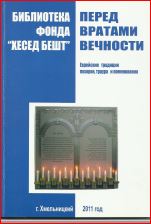| "Chesed-Besht" Khmelnitskiy
Regional Welfare Fund publication Khmelnitskiy (Proskurov) Cemetery List of Burials |
 Link to 2011 published brochure Yaroslav Mikhaylovsky supplied a copy of this publication . |
| There are more pictures of the cemetery
here Link |
| The presented brochure, “At the Gate of
Eternity: Traditions of the Jewish Funeral, Mourning and
Remembrance”, includes, as the most important part of it,
the catalogue of the graves and grave marks survived on
the latest Jewish cemetery of the city of Khmelnitskiy
(before 1954 - Proskurov). This cemetery was used for
funerals in 1930s-1960s. Up to recent time, it has
restored and turned to the Museum in the open air by the
workers of The Jewish Charity Society Hesed-Besht of
Khmelnitskiy. Its director is Igor Рatushnyy. He was also
the author-compiler of the brochure which was published in
Khmelnitskiy in 2011. Below is short information on the history of the previous Jewish cemeteries of Proskurov which existed there since the end of 17 century. The first and the oldest one, which we have some data of, was located on the then outskirts of the city. Now it’s just its center – Kamenetskaya Street, 48, near the Artists’ Club. It was used for funerals from the end of 17 century to the beginning of 19 century. In 1824, after this cemetery was overfilled, the municipal authorities presented the new plot at the disposal of the local Jewish community for using it as a next cemetery. On its place later there was erected the .building of the State Metrology Agency. Its address is Svobody (Freedom) Street, 7. Attached on the wall of this .building are two plaques with the Russian and Hebrew texts on them informing that the Jewish cemetery was located at this place. In the small public garden next to the Metrology Agency building, the memorial sign was erected on the place where there were buried, in accordance with the information given by the Head of “Ohaley Tzaddikim” (The Tents of the Righteous) Association, Israel Meir Gabai, two Admors (local Chassidic leaders). Their names were Arye Yehuda Leibish Liberson (the grandson of the Great Rabbi Liber from Berdichev, the tatter was the BEShT’s contemporary) and Moshe Haim Efraim from Proskurov. This cemetery was closed in 1870 when the South –West railroad passed through Proskurov. Soon after that, the next, new cemetery was opened. This certain cemetery was located next to Tolstoy Street. There the victims of 1919 terrible Proskurov pogrom were buried, and on its territory the great and well-known Memorial was erected just on the victims’ mass grave place. After that disappeared cemetery, the new one was founded on the same Tolstoy Street. It was just that cemetery, which exists now as the Museum. No new funerals since 1965 there occurred in it. It was the last separate Jewish cemetery of Khmelnitskiy. After 1965, Jews have been buried in the Jewish sections of the municipal cemetery near the village of Sharovechka that located beyond the Eastern border of the city. In 2003, the Jewish Charity Society Hesed-Besht of Khmelnitskiy initiated the great project, connected with the restoration this latest cemetery and turning it into the museum, a part of the museum complex “The light of the Soul”. It was started with erected the strong new fence. Then the vegetation was removed from the territory of the cemetery – huge trees and bush. Later the huge amount of garbage was removed, the paths were asphalted, etc. The necessary financial aid came from the local businessman, Grigoriy Galperin and from the emigrants, former Proskurov natives and their descendants. Immediately after the fulfilling this important job of the cemetery cleaning and restoration, the employees and volunteers of Hesed-Besht fulfilled the topographical description plus the composing of the catalogue of the graves and grave marks which is the very important part of the cemetery rebirth. The full amount of graves of this cemetery is 1114! Unfortunately, some names and epitaphs were unreadable, and besides, there were no experts in Hebrew among them, so the inscriptions in Hebrew (names in Hebrew alphabet, as well) stayed unread and unknown and each of them was marked in the catalogue as “Hebrew inscription”. Nevertheless, the brochure, in whole, and especially the catalogue of the cemetery grave marks, included in it, is very important document for the investigating the Jewish history of Khmelnitskiy. Yaroslav, Mikhaylovsky, Khmelnitskiy. Edited and translated into English – Eugenia Sheinman |